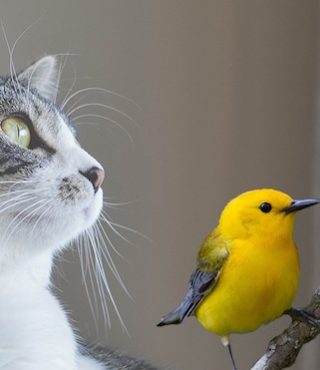An Emerald Bird Called Emi

I have the story of a lifetime—a story from the very jungles of Costa Rica.
My husband Aamer and I were driving from an ecolodge to a biological reserve in Costa Rica and decided to stop for a break. We sat in a restaurant and looked out the window to find a cat meowing as it stared up a tree. A green bird perched on a branch, her eyes closed, her feathers fuzzy.
We learned from a Swedish couple in the restaurant that she’d hit her head by flying against the glass windows, and now could no longer fly properly. The cat was waiting to eat her. In fact, cats kill billions of wild birds and mammals each year in the United States alone, posing an immense threat to wildlife.
We decided to save the bird from the clutches of the cat. The restaurant owner brought out a ladder from his kitchen and leaned it against the tree. I’m scared of heights but climbed up the tree, while Aamer kept the cat at bay and the restaurant owner urged me higher and higher in Spanish.
Finally, my hand wrapped around the bird. She was beautiful, with bright green feathers and a long, pointed black-and-golden beak. She was an emerald toucanet, a species local to Central America, a fruit-eating bird that lives in small flocks.
We decided to name her Emi.
With Emi in hand – weak, silent, and unreactive — we began our race against the clock. It was almost 5:30pm, just before sunset, and most veterinarians would be closed for the evening. I called my sister in Washington DC and she managed to find a veterinarian, a Dr. Suarez, close to our destination, Monteverde. He was just about to go home for the day but was kind enough to stay open an extra hour for us. We drove incredibly fast on the dirt road, our teeth chattering with every rocky bump. We offered Emi banana, but her head continued to hang low in my hands.
When we reached Dr. Suarez, he examined Emi and concluded that she was dazed and confused from having hit her head, but was otherwise unharmed. She was fortunate, for up to a billion birds die from glass collisions in the United States alone. The reason is that, to birds, the trees and sky reflected in glass appear to be natural habitat. They think they’re flying into the safety of a tree but end up flying into a window. Simple, cost-effective solutions to these collisions include curtains, adhesives, and certain kinds of glass.
Dr. Suarez kept Emi in a cage for observation over the next day. She refused to eat a single bite of food and instead continually poked her head out through the bars of her cage, visibly agitated. Keeping her in a cage for a day was necessary, but showed us the stress and unhappiness caused by bird-caging. And yet countless millions of birds are kept imprisoned throughout the world, making a mockery of the idea of a pet. The expression ‘free as a bird’ is not a coincidence — birds are meant to be free.
The next day, we drove Emi back to her home. We’d barely opened her cardboard box when she flew right out and perched on a tree. With her green feathers, she blended perfectly into the leaves. She sat on the branch, enjoying the breeze, fluffing her feathers, and looking about her.
Emi showed us the fragility of the bond between humans and the wild. Whether intentionally or accidentally — through our windows or our cats, through caging birds or driving — we wreak havoc on wild animal lives. We are everywhere, while, increasingly, they are nowhere. Fortunately, we can choose to mitigate our impact, from the pets we keep to our window design. Greater caution on the roads is also instrumental, as I describe in an article in Huffington Post.
This post is by Sonia Faruqi, and is republished with her permission. To read more of Sonia’s blogs, visit soniafaruqi.com. Her most recent book, Project Animal Farm, offers a revealing look at what happens behind farm doors.








